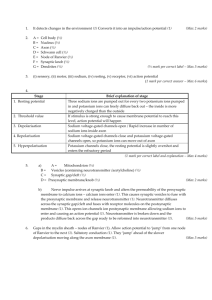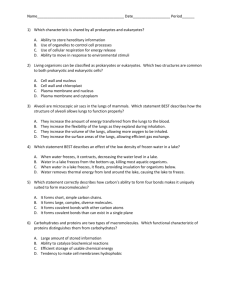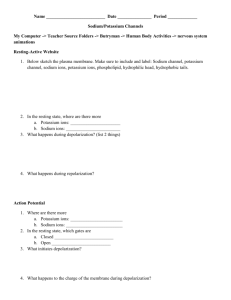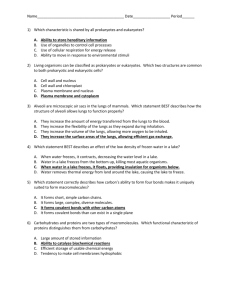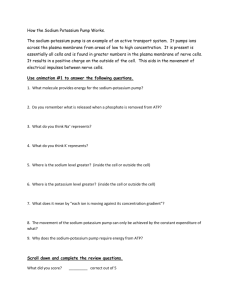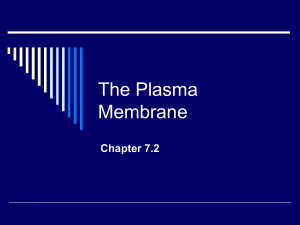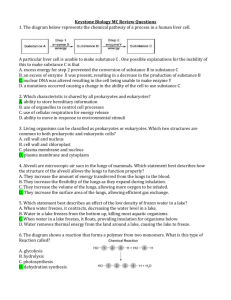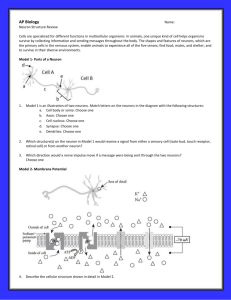Name: Date: ___/___/___ Period: ____ Keystone Practice
advertisement
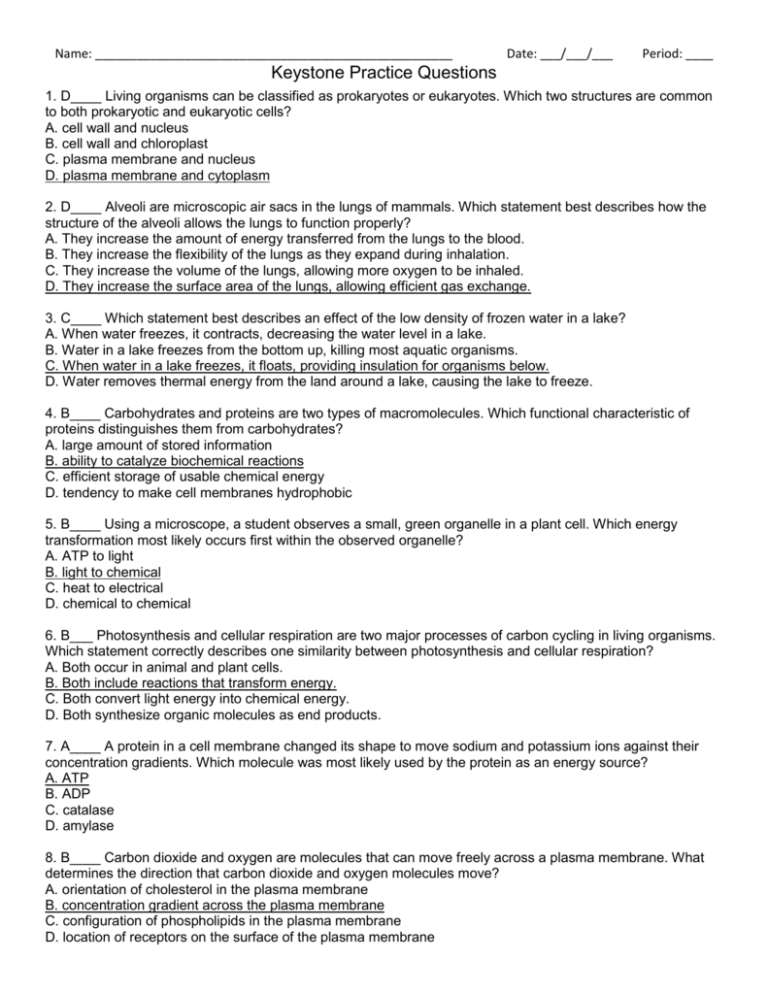
Name: ____________________________________________________ Date: ___/___/___ Period: ____ Keystone Practice Questions 1. D____ Living organisms can be classified as prokaryotes or eukaryotes. Which two structures are common to both prokaryotic and eukaryotic cells? A. cell wall and nucleus B. cell wall and chloroplast C. plasma membrane and nucleus D. plasma membrane and cytoplasm 2. D____ Alveoli are microscopic air sacs in the lungs of mammals. Which statement best describes how the structure of the alveoli allows the lungs to function properly? A. They increase the amount of energy transferred from the lungs to the blood. B. They increase the flexibility of the lungs as they expand during inhalation. C. They increase the volume of the lungs, allowing more oxygen to be inhaled. D. They increase the surface area of the lungs, allowing efficient gas exchange. 3. C____ Which statement best describes an effect of the low density of frozen water in a lake? A. When water freezes, it contracts, decreasing the water level in a lake. B. Water in a lake freezes from the bottom up, killing most aquatic organisms. C. When water in a lake freezes, it floats, providing insulation for organisms below. D. Water removes thermal energy from the land around a lake, causing the lake to freeze. 4. B____ Carbohydrates and proteins are two types of macromolecules. Which functional characteristic of proteins distinguishes them from carbohydrates? A. large amount of stored information B. ability to catalyze biochemical reactions C. efficient storage of usable chemical energy D. tendency to make cell membranes hydrophobic 5. B____ Using a microscope, a student observes a small, green organelle in a plant cell. Which energy transformation most likely occurs first within the observed organelle? A. ATP to light B. light to chemical C. heat to electrical D. chemical to chemical 6. B___ Photosynthesis and cellular respiration are two major processes of carbon cycling in living organisms. Which statement correctly describes one similarity between photosynthesis and cellular respiration? A. Both occur in animal and plant cells. B. Both include reactions that transform energy. C. Both convert light energy into chemical energy. D. Both synthesize organic molecules as end products. 7. A____ A protein in a cell membrane changed its shape to move sodium and potassium ions against their concentration gradients. Which molecule was most likely used by the protein as an energy source? A. ATP B. ADP C. catalase D. amylase 8. B____ Carbon dioxide and oxygen are molecules that can move freely across a plasma membrane. What determines the direction that carbon dioxide and oxygen molecules move? A. orientation of cholesterol in the plasma membrane B. concentration gradient across the plasma membrane C. configuration of phospholipids in the plasma membrane D. location of receptors on the surface of the plasma membrane 9. B____ A sodium-potassium pump within a cell membrane requires energy to move sodium and potassium ions into or out of a cell. The movement of glucose into or out of a cell does not require energy. Which statement best describes the movement of these materials across a cell membrane? A. Sodium and potassium ions move by active transport, and glucose moves by osmosis. B. Sodium and potassium ions move by active transport, and glucose moves by facilitated diffusion. C. Sodium and potassium ions move by facilitated diffusion, and glucose moves by osmosis. D. Sodium and potassium ions move by facilitated diffusion, and glucose moves by active transport. 10. D____ Mitosis and meiosis are processes by which animal and plant cells divide. Which statement best describes a difference between mitosis and meiosis? A. Meiosis is a multi-step process. B. Mitosis occurs only in eukaryotic cells. C. Meiosis is used in the repair of an organism. D. Mitosis produces genetically identical daughter cells. 11. D____ In a flowering plant species, red flower color is dominant over white flower color. What is the genotype of any red-flowering plant resulting from this species? A. red and white alleles present on one chromosome B. red and white alleles present on two chromosomes C. a red allele present on both homologous chromosomes D. a red allele present on at least one of two homologous chromosomes Use the table below to answer the question. Blood Types Genotypes(s) Phenotype ii O A A A A I I ,I i B B B B I I ,I i A B AB I I 12. D____ Blood type is inherited through multiple alleles, including IA, IB, and i. A child has type A blood. If the father has type AB blood, what are all the possible phenotypes of the mother? A. phenotypes O or A B. phenotypes A or AB C. phenotypes A, B, AB D. phenotypes O, A, B, AB Use the diagram below to answer the question. 13. D____ Which type of change in chromosome composition is illustrated in the diagram? A. deletion B. insertion C. inversion D. translocation Use the circle graphs below to answer the question. 14. B____ The graphs illustrate change in a lizard population over time. Which process most likely led to the change in the lizard population? A. natural selection acting on a harmful trait B. natural selection acting on a beneficial trait C. natural selection acting on a dominant trait D. natural selection acting on a recessive trait Use the table below to answer the question. Quantitative Student's Observations of a Pond Ecosystem Qualitative 37 fish and 3 frogs 2 types of aquatic grass 12 small rocks and 1 medium rock sand Leaves lie on the bottom of the pond. Water insects move along the water's surface. All 3 frogs are sitting on a pond bank. 15. D____ A group of students measured a ten-square-meter section of a pond ecosystem and recorded observations. Which statement is a testable hypothesis? A. The frogs living in the pond represent a population. B. Water is an abiotic component in the pond ecosystem. C. If the fish are given more food, then they will be happier. D. If the frogs are startled, then they will jump into the water. Use the list below to answer the question. Observations • two grey wolves • five moose • several species of conifer trees • large granite rock • shallow pond 16. C____ A student wrote several observations in a field notebook. Which term best classifies all of the student’s observations? A. population B. food chain C. ecosystem D. community 17. A____ A species of snapping turtles has a tongue that resembles a worm. The tongue is used to attract small fish. Which best describes the interaction between the fish and the snapping turtle? A. predation B. symbiosis C. parasitism D. competition 18. B____ A farmer observed that an increase in a field’s soil nitrogen content was followed by an increase in producer productivity. What does this observation most likely indicate about the relationship between nitrogen and the producers in the field? A. Nitrogen was a biotic factor. B. Nitrogen was a limiting factor. C. Nitrogen became a surplus resource. D. Nitrogen became a selection pressure. 19. A____ Which of the following characteristics of living things explains why birds fly south for the winter? A. Living things respond to their environment B. Living things maintain homeostasis C. Living things are made of cells D. Living things are based on a universal genetic code 20. B_____ Cells in multicellular organisms have many sizes and shapes. These differences are referred to as cell specialization. Cell specialization allows cells to: A. Reproduce B. Perform different functions C. Respond to their environment D. Be less complex 21. C_____ Which of the following answers is not a characteristic of life? A. Made up of cells B. Reproduction C. Performs photosynthesis D. Uses Energy 22. A____ In order for cells to divide successfully, the cell must first do what? A. Duplicate its genetic information B. Decrease its volume C. Increase its number of chromosomes D. Decrease its number of organelles 23. B____ An ecologist company is looking at an ecosystem where a certain bug species has gone extinct and the role that species played in the environment. What is the role of that species of insect also known as? A. Abiotic Factor B. Niche C. Biotic Factor D. Hardy-Weinberg Equilibrium 24. C____ Darwin observed many species of finches on the Galapagos islands. In his book, On the Origin of Species, Darwin described the process that created so many different types of finches from one common ancestor of species. What is that process called? A. Carrying Capacity B. Energy Conversion C. Natural Selection D. Artificial Selection
